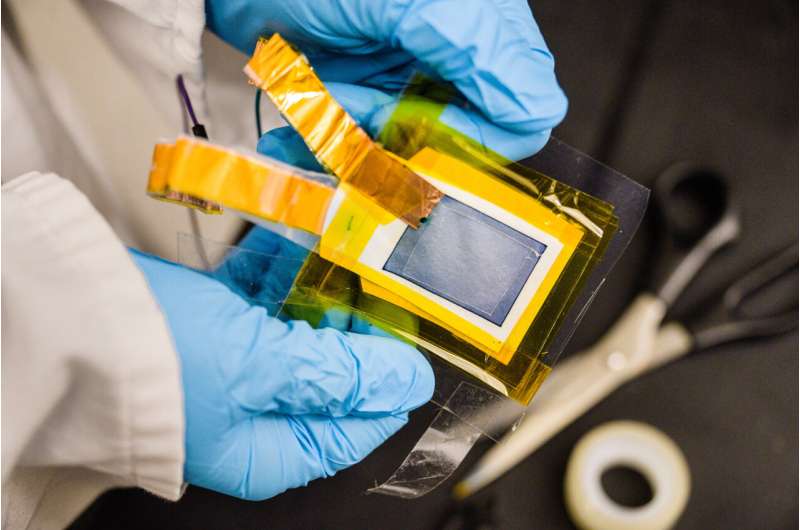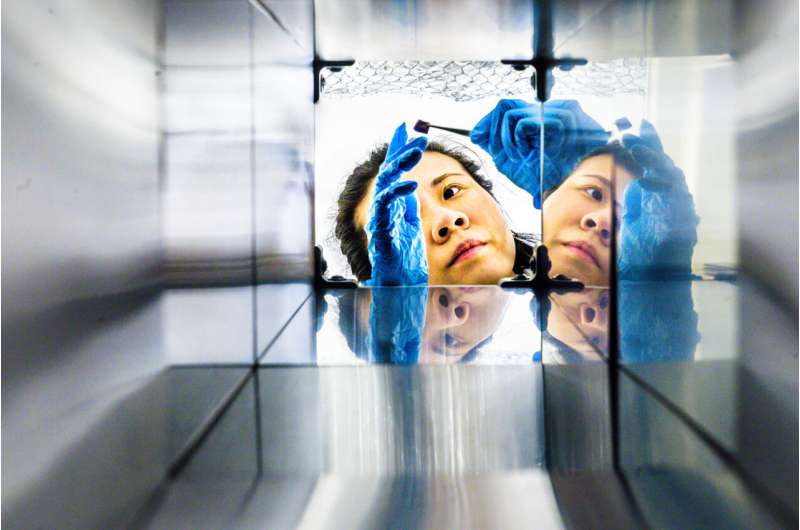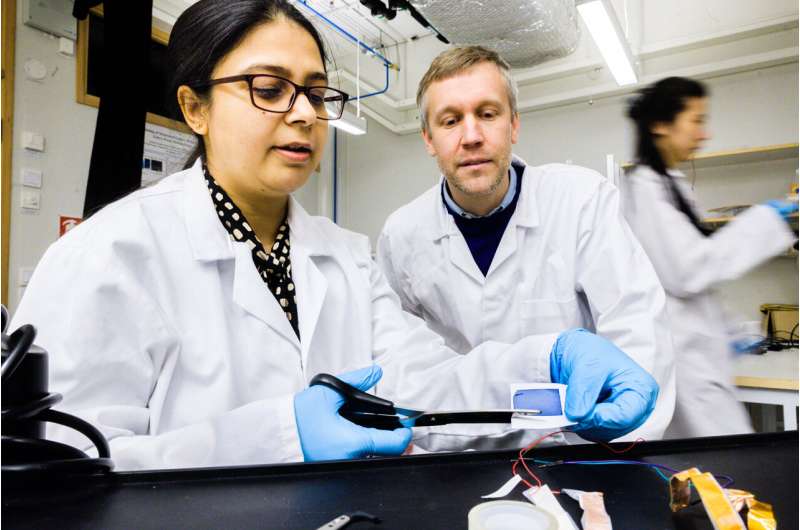An electrically controllable passive radiant cooling device. It is based on a controllable conductive polymer on top of a porous paper with an electrolyte. Credit: Thor Balkhed
Energy-efficient ways of cooling buildings and vehicles will be required in a changing climate. Researchers at Linköping University have now shown that electrical tuning of passive radiative cooling can be used to control temperatures of a material at ambient temperatures and air pressure. The results have been published in Cell Reports Physical Science.
"To cool buildings, for example, traditional air conditioning is mainly used today, which requires large amounts of energy and uses environmentally hazardous refrigerants. With the help of passive radiative cooling, the cold of outer space could be used to complement normal ACs and reduce energy consumption," says Magnus Jonsson, professor and leader of the Organic Photonics and Nano-Optics group at Linköping University.
Passive radiative cooling utilizes that thermal energy can leave an object in the form of infrared radiation. All objects emit heat as infrared light—trees, buildings, water and even humans.
Different types of materials emit different amounts of infrared heat. This depends on the ability of the material to absorb infrared radiation—the better it is at absorbing infrared heat, the better the material is at emitting the heat. For example, ordinary white writing paper is good at absorbing infrared heat and, consequently, at emitting it. By contrast, metals are rather bad at it, as most of the heat is reflected.
Due to the atmosphere's ability to transmit light in the infrared wavelength range, coldness in outer space, where the temperature is about -270 degrees Celsius, can be used to remove heat from objects on earth. As a result of the temperature difference, there can be a net transport out. An object can therefore get a lower temperature than the ambient temperature with the help of passive radiative cooling.
Mingna Liao photographed through the sky simulator built by the researchers. Credit: Thor Balkhed
This effect has been used far back in history, such as to make ice in warmer climates. However, in recent years, materials science research has taken an increasing interest in the phenomenon, and has developed new materials with a high capacity to emit infrared heat while not being warmed up by the rays of the sun.
Researchers at Linköping University have now shown that the temperature of a device can be regulated by electrically tuning the extent to which it emits heat through passive radiative cooling. The concept uses a conducting polymer to electrochemically tune the emissivity of the device. The results have been published in the journal Cell Reports Physical Science.
"You can liken it to a thermostat. Currently, we can adjust the temperature by 0.25 degrees Celsius. It may not sound like much, but the point is that we have shown that it is possible to carry out this tuning at room temperature and normal pressure," says Debashree Banerjee, principal research engineer at Linköping University and principal author of the study.
The researchers believe that, now that they have shown that it is possible, there is potential to further develop both materials and devices. In the long term, it is possible to envisage systems that can be laid on a roof, much like a solar cell, thus controlling the infrared thermal radiation from the house and cooling when needed. The method requires extremely little energy consumption and causes minimal pollution. Other areas of application can also include tunable clothing and wallpaper to thermal flows and improve thermal comfort indoors at lowered energy consumption.
Debashree Banerjee (left) prepares a device with passive radiative cooling that can be controlled electrically. Magnus Jonsson in the middle and Mingna Liao in the background. Credit: Thor Balkhed
In another study published in Advanced Science, the same research group has developed a thermoelectric device that is powered by the same principle of radiative cooling, also complemented by solar heating. It is based on generating a temperature difference between two cellulose materials, one of which contains carbon black to also absorb the heat of the sun. The materials are connected to a material that converts the temperature difference into an electrical potential. Exposing the device to the sky induced an electrical voltage of 60 mV already at moderate solar radiation, but the concept even works at night since the two wood-based materials are designed to have different abilities to radiate heat.
"We use not only the sun, but also outer space as an energy source," says Mingna Liao, Ph.D. doctoral student in the group and principal author of the article in Advanced Science.
In order to perform controlled measurements for both studies, the researchers built a sky simulator. In this way, the measurements were not affected by changes in the environment in the same way as they would be outdoors. The sky simulator consists of a tube with aluminum-coated sides that reflect the radiation. A receptacle placed at the bottom contains a material that absorbs the heat radiation and is cooled with liquid nitrogen to simulate the coldness of outer space.
More information: Magnus P. Jonsson & colleauges, Electrical Tuning of Radiative Cooling at Ambient Conditions, Cell Reports Physical Science (2023). DOI: 10.1016/j.xcrp.2023.101274. www.cell.com/cell-reports-phys … 2666-3864(23)00033-4
Mingna Liao et al, Cellulose‐Based Radiative Cooling and Solar Heating Powers Ionic Thermoelectrics, Advanced Science (2023). DOI: 10.1002/advs.202206510
Journal information: Cell Reports Physical Science , Advanced Science
Provided by Linköping University


























